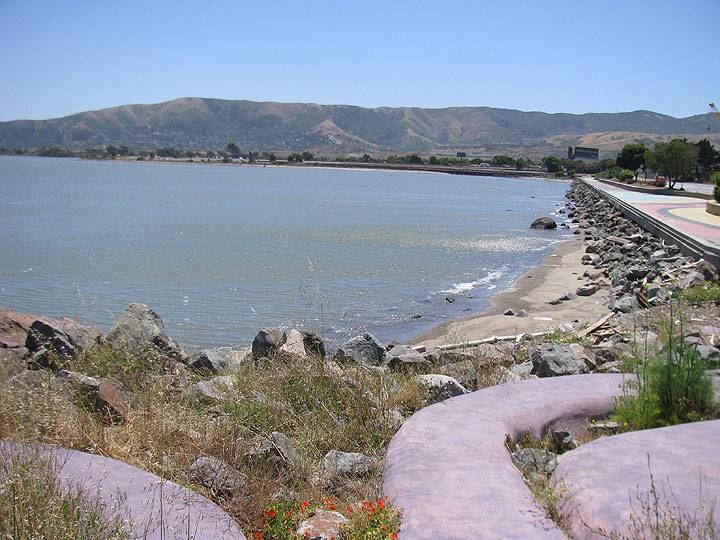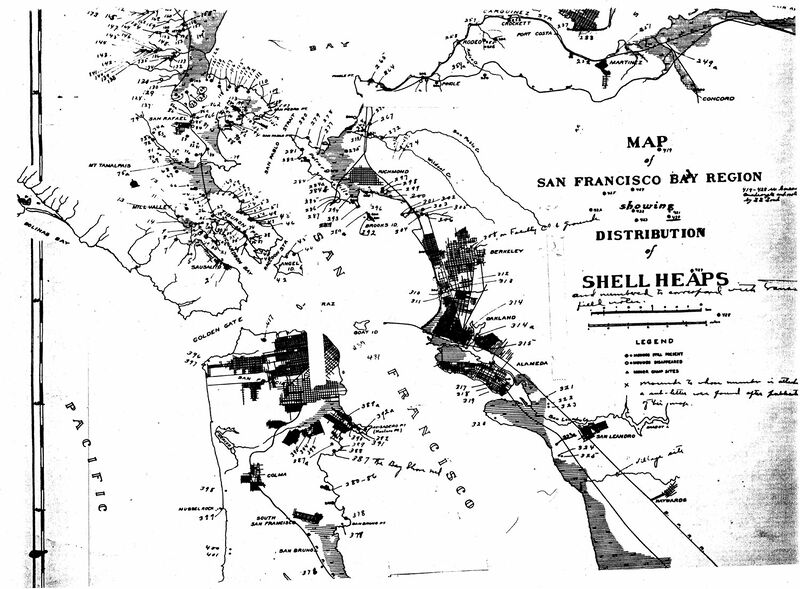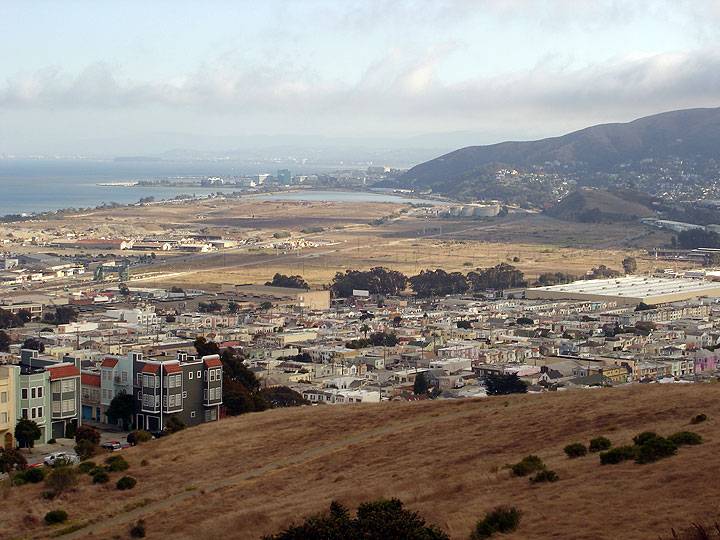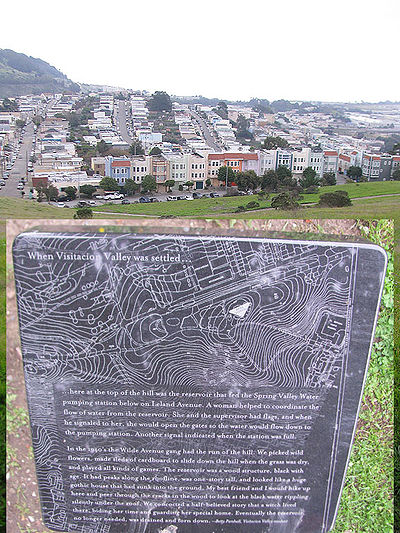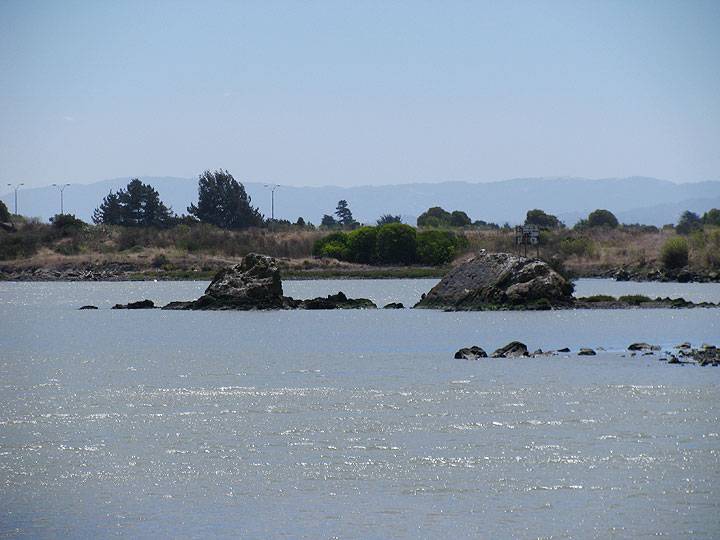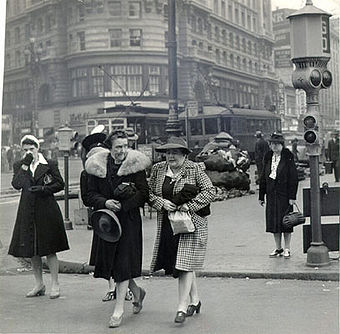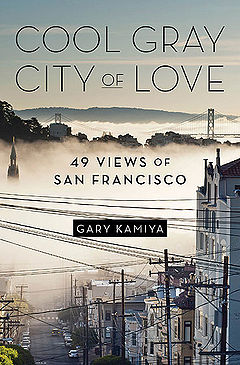Searching for the Yelamu in San Francisco
Historical Essay
© By Gary Kamiya, excerpted with permission (see bottom for more info). Originally this chapter was titled "Dancing on the Brink of the World".
Site of original Crocker Mound, now a re-created beach southwest of Candlestick Park, just east of Highway 101.
Photo: Chris Carlsson
During my endless wanderings through San Francisco, I often found myself thinking about the first people who lived here, the Yelamu. They intrigued me for several reasons. For one thing, we were both fascinated with the same little piece of turf. Like all California Indians, the Yelamu were passionately devoted to their home territory. They knew every inch of it. The 19th- century journalist and adventurer Stephen Powers wrote that mothers of the Mattole tribe of northwestern California taught their children their tribal boundaries by reciting its features “in a kind of sing-song,” repeating the names of boulders, trees, canyons, and other landmarks until the children had learned every foot of their domain. Since this was an almost exact description of my own increasingly problematic behavior since I began to work on this book—I actually once forced my daughter to learn an inane sentence whose words were reminders of street names in our neighborhood—it was clear to me that the Yelamu were either kindred spirits or escapees from the same mental hospital. Either way, I wanted to know more about them.
Then there was my abiding interest in the city’s primordial landscape, the city before the city. The Yelamu had moved naked through a naked world. I thought that by learning more about them, I might be able to imagine that harsh and innocent terrain.
The native people who lived in San Francisco, the Yelamu, were members of a larger group of Indians called the Ohlone, or, as the Spanish called them, the Costanoans. The Ohlone shared many cultural practices, but they were not a tribe and were not politically or ethnically unified; “Ohlone” refers to a language family consisting of either six or eight languages. Numbering between 10,000 and 17,000 at the time of Spanish contact, the Ohlone occupied the area from the San Francisco Bay south to Big Sur and east toward the Central Valley. They lived in about 50 politically autonomous communities or tribal groups, each with from 50 to 500 people and a number of villages, some permanent, some seasonal.
In trying to imagine San Francisco during the endless years that the Ohlone lived here, the first thing you have to get your head around is how few of them there were. About 1,500 Ohlone lived on the peninsula, with a proportional number inhabiting the 10 percent of the peninsula occupied by San Francisco. Randall Milliken, an expert on the Yelamu and author of an authoritative study of the destruction of Bay Area Indian culture, A Time of Little Choice: The Disintegration of Tribal Culture in the San Francisco Bay Area, 1769–1810, estimates that San Francisco’s population was between 160 and 300 people at European contact—less than the number of people who live in some of the apartment buildings down the street from my house. For thousands of years, you could walk clear across San Francisco and barely see a soul.
The Yelamu were made up of one or two dozen related families, with each family averaging 15 members. They lived in a non-hierarchical way, but that did not mean they exalted individuality. For them, as for all California Indians, the individual was nothing, the family and the group everything. “What is a man?” a Pomo Indian once asked. “A man is nothing. Without his family he is of less importance than a bug crossing the trail, of less importance than spit or dung.”
The essence of Yelamu life, like that of all California Indians, was interdependence, respect for the natural world, and a cosmic order preserved by ritual, self-purification, and moderation. The Yelamu did not practice agriculture, but they were expert hunters and knew every edible and medicinal plant that grew within the boundaries of their little world. Their practices allowed them to survive for millennia, without doing major damage to the earth.
The center of social life, for men, was the temescal, the sweat lodge, where they gathered to socialize and hang out. Both sexes met at village centers where stories were recited, and traditional songs sung again and again, accompanied by endless dancing—another link with the frolicsome city to come. A persistent complaint among early Spanish settlers was that the Indians’ endless singing prevented them from sleeping.
A few fragments of Ohlone songs have come down to us. One seems to be a form of sympathetic magic, like the ancient cave paintings at Lascaux and Altamira: “I dream of you, / I dream of you jumping. / Rabbit, / Jackrabbit, / Quail.” There is an endearingly direct line from a love song: “Come! Come! I mean you with the brown hat.” And last, and most haunting, a single line that could be the city’s motto: “Dancing on the brink of the world.”
I wanted to find the exact locations where these spiritual, conservative, deeply resourceful people had lived. In the back of my mind lurked memories of a trip I made many years ago to the Little Bighorn Battlefield National Monument in Montana. Scattered across the old battlefield were dozens of white marker stones, on the rolling hills and down in the ravines, each one marking the place where a soldier had fallen. In 1999, several red granite stones were added, commemorating the places where Indian warriors had died. The random specificity of these stones pierced me, brought that long-gone day alive. I wanted to put similar markers in the streets of San Francisco.
The first place to start was with shellmounds—the largest and most dramatic artifacts left by the local Indians. In 1909, a U.C. Berkeley graduate student named Nels Nelson cataloged 425 of them in the Bay Area, including 18 in San Francisco. At the most rudimentary level, these enigmatic, now-vanished mounds, some of which are as old as 3,500 years, bear witness to the vast quantities of shellfish consumed by the Ohlone. But archaeologists believe they were more than garbage dumps: They were also territorial landmarks, ceremonial sites, and burial grounds. And the Ohlone lived on top of them. For reasons that are unclear, the shell mounds were gradually abandoned after 700 c.e.
A section of Nels Nelson's 1909 map of shellmounds around the Bay Area.
Image: Shaping San Francisco
Including the shell mounds, there are about 50 places in San Francisco where Indian artifacts have been discovered. Most of them are in the city’s deep south— near Islais Creek, at the Hunters Point shipyard, or in Visitacion Valley, with a few in the Bayview. There is a major site by Mission Creek and one by Mission Dolores. There are a half dozen sprinkled across the northern waterfront, including three found recently in Fort Mason, and a site off Merrie Way at Point Lobos, near a 19th-century workingman’s fair called the Pleasure Grounds created by San Francisco’s Santa Claus, Adolph Sutro. There are a few oddball outliers, including a skeleton unearthed in 1861 at Beach and Hyde, at the bottom of Russian Hill where the Buena Vista bar now stands. Some are in the western part of the city: a couple of sites by Lake Merced and the “sparse remains of bones” found on the S.F. State campus. Near the Civic Center BART is a site where the 5,000-year-old bones of a woman were found. Finally, there are several sites on or south of Market Street, including one at Third and Harrison, one at Ecker and Stevenson, and one at Fifth and Market.
To make sense of this mess, I called up Randall Milliken. He said the Yelamu were composed of three semi-sedentary groups, all related. One group moved seasonally along Mission Creek, from a winter village called Sitlintac on the shore of the bay just south of AT&T Park, to a summer village, Chutchui, near Mission Dolores three miles inland. The second group moved between Tubsinthe, a large winter village on a cove south of Candlestick Park, and the summer village, Amuctac, in nearby Visitacion Valley. The third cluster of families lived seasonally at Petlenuc, near the beach area facing the sea and the Golden Gate.
Milliken said that the usage of these sites was casual. “There were always five or six sites,” he said. “San Francisco was like a great big campsite where you just move around and pick out the one you like the best. The two big ones were on the bay, at Visitacion and at Mission Creek. Suppose you’re living down at Visitacion, you’ve got an aunt and uncle up by the Presidio (at Petlenuc), maybe you have some bad crops two or three years in a row, so you move up there. They used the whole peninsula.”
I asked Milliken if he knew where all the sites were in San Francisco. “The sites don’t matter that much,” he replied. “They’re all buried under stuff. You should just walk around San Francisco and look for the best places, where there’s water and it’s warm and protected from the wind, and visualize what it looked like before 1776.” For someone determined to put a plaque on the site of every long-vanished bush where some Yelamu hunter once pissed, this answer was not encouraging.
The former Bolinas Lagoon, now long filled with San Francisco's garbage and slated to become a mall, with Visitacion Valley spreading out to the west, as seen from McLaren Park in September, 2005.
Photo: Chris Carlsson
Visitacion Valley/Little Hollywood neighborhood, with explanatory plaque on McLaren Park "Philosopher's Way" path, 2012
Photo: Chris Carlsson
I asked Paul Scolari, the American Indian liaison for the National Park Service in San Francisco, about the sites at Crissy Field, the historic aviation field on the northern waterfront, now a glorious urban promenade. “There’s one located just east of the marsh near the beach, the other buried under the Sports Basement (a big retail store),” Scolari said. Archaeological evidence indicated they were food-processing camps, he explained, but beyond that little was known about them or how they were used. “No one really knows the life patterns,” he said. “This is the coldest place on the peninsula, so these were presumably summer camps, but how much they moved about on the peninsula, how long they stayed in one place, is conjectural.”
The experts had basically told me to get out there and use my imagination. It was time to hit the streets.
I decided to head first to the site of the largest shell mound found in San Francisco, the so- called Crocker Mound, or CA-SFR-7, in the poetic official nomenclature. The Crocker Mound was believed to be the site of Tubsinthe, the big winter village. It was probably the most important site in San Francisco. Information about archaeological sites is semi- classified, but in an environmental impact report for the proposed development in Hunters Point, I discovered that SFR-7 is located about a third of a mile southwest of Candlestick Park, on what was once a sheltered cove and lagoon off Harney Way near the Candlestick Point State Recreation Area.
I drove down Highway 101 and parked on the edge of the huge Candlestick parking lot. Traffic noise from the freeway hummed in the distance. The big stadium, where I once saw Willie Mays make a basket catch and Jerry Rice break the all-time touchdown record, stood empty. To the north, the derelict shipyard of Hunters Point loomed up, behind the gaunt Double Rock housing projects. There were Indian sites all over the place around here—13 or 14 within a half mile.
A funky scene was going down in the parking lot. A couple of black guys smoking a joint in a parked car looked warily at me as I went past. A Latino man in a City of San Francisco car was taking a nap, the seat back and his mouth open. A group of friendly older black men were firing up an enormous barbecue on wheels, which they had pulled behind a pickup truck. They had enough ribs, burgers, and sausages flaming away on it to feed an army. It wasn’t clear who they were barbecuing for. Off the rocky point beyond them, a few windsurfers were riding in hard on the wind- chopped waves.
I wandered through the little-used recreation area. Except for the windsurfers and a woman being dragged along by a huge, wolflike dog, it was deserted. A jackrabbit came bounding through the grass and disappeared. I wandered out to the end of a fishing pier, where two Chinese men were smoking cigarettes and rummaging through an ice chest. They said they had caught a shark. Off to the west, above the placid waters of the bay, a billowing cloud hung over Mount San Bruno.
I walked toward the north. The ranger station was boarded up. The Candlestick parking lot, where my father taught me how to drive, faded into vacant-lot squalor on the north side, with odd chained-off roads leading nowhere, their asphalt cracking. A rusty sign pointed toward a defunct boat-launching ramp, near a closed public bathroom and a row of broken light poles. Beyond it, I recognized the polluted beach of Double Rock, the most obscure and waste-strewn stretch of waterfront in San Francisco, which I had stumbled on a few months earlier after climbing through a gap in a cyclone fence behind a trucking company off Armstrong. Behind it, the old World War II plants at Hunters Point drowsed. The scene looked like a Futurist painting by Mario Sironi.
Double Rock, which has given its name to a nearby housing project, but here are the actual geographic items, with the manmade "beach" next to Candlestick's parking lots just behind it.
Photo: Chris Carlsson, 2012
I walked over to the south side of the parking lot and headed southeast. In a few minutes I came upon a forlorn little beach, filled with broken-up bricks and pieces of stone. South of that beach was a longer, narrow strip of rocky shoreline, below a walkway. The city dump, located right on the county line, was across the nearby freeway. Nels Nelson had described the site as located on “the first cove north of the San Francisco and San Mateo County Lines.” An 1862 Coast Survey map showed that the shell mound was located on a small sandy terrace that faced both the bay and a lagoon, now long gone.
There was no sign of any shell mound, but this strange little beach was where Tubsinthe had once stood.
If you closed your eyes and made the freeway and the dump and the parking lot and the Executive Park development and the ambient industrial wasteland vibe go away, you could understand why people had chosen to live here, and kept living here in basically the same way longer than almost any people have ever lived anywhere on this planet. It was warm—by San Francisco standards, anyway. It was close to an old vanished branch of Islais Creek and to the groves of oak and buckeye trees that once grew here. It was steps away from the shellfish-rich mudflats. And it fronted a part of the bay calm enough to cross to the East Bay by tule-reed boat.
This was now a forgotten backwater of San Francisco, bordering some of its most blighted and crime-ridden neighborhoods, seven miles from downtown. But when Greece was in its archaic period, and for more than 1,000 years after that, this was a swankier San Francisco address than Pacific Heights or Seacliff.
Crossing Tubsinthe off my list, I decided to explore some of the sites closer to downtown. I visited a site known as the Market Street shell midden, SFR-113, buried under the southeast corner of Market and Fifth Streets. It was discovered during archaeological testing for excavations for the San Francisco Shopping Centre. Today this intersection is in the busiest part of the city, a half block from the Powell Street cable car turnaround. But before the city existed, this was a no-man’s-land of parallel, east-west running sand ridges, some as high as 80 feet. There were no known streams in the area. The bay was more than 500 yards away to the east.
No one was quite sure what the Yelamu, or their ancestors, had been doing in these high sand hills. According to the field report on this site, it was occupied during two different periods—first around 120 b.c.e., then around 120 c.e. But beyond that, the authors of the report, Allen Pastron and Michael Walsh, admitted they were stumped. The artifacts were a “vague and confusing array.” They concluded that it was probably a site where foragers would return, a “low bulk” procurement site where only limited quantities of food, in particular rabbits, were found. They speculated that the Indians had been drawn to it “because it represented high ground in close proximity to the salt marshes and tidal flats that lay immediately to the east and south.” In conclusion, they called it “perhaps the most poorly understood region in the entire Bay Area.”
Amen to that, I thought. I certainly understood nothing. I’d walked past this corner a thousand times. It was packed with people. Shoppers hurried past with Nordstrom bags. Well-disciplined European families walked purposefully along. Streetcars rolled past. There was absolutely nothing to evoke the people who had sat for unknown reasons atop high sand hills here a thousand years ago. I placed my figurative marker, but it was a purely mechanical operation.
Over the next few weeks I checked out several other sites, but none of them brought the Yelamu alive. The changes had been too great. I went on to other things.
A few months later I was standing at dusk on the little lawn at the top of Vallejo Street on Russian Hill, drinking a margarita in a red plastic cup and looking out at downtown and the Bay Bridge. I had walked up to this magical little square of public green via a circuitous and illogical route from North Beach. It struck me that if some deity with too much time on his hands had mapped my movements, the way Paul Auster recorded one of his characters’ movements through Manhattan in City of Glass, the way I was trying to map the Yelamu, it would have looked like a meaningless Jackson Pollock squiggle. That thought led me to ponder what the Yelamu might have been doing in those high sand dunes on Market Street, “perhaps the most poorly understood region in the entire Bay Area.” I took a sip of my drink. At some point in the past few thousand years, surely someone wandered up there with the Ohlone equivalent of a margarita, plunked herself down in the warm sand, and looked out over the bay, for no reason at all.
Stymied by the things that separated us, I had forgotten the things we had in common. I had been trying too hard. I didn’t need to totally inhabit their minds and souls: All I needed was to find a few mundane things we shared. And one of them was the simple pleasure of being here, in this place we both called home.
It was a small place. But we both loved it precisely because it was small. In a Maidu myth, Earthmaker told the people he had just created, “Living in a country that is little, not big, you will be content.” That contentment united the Yelamu not just with me, but every city dweller who loves her neighborhood. The Yelamu had arranged their lives so they could do almost all of their business within a short walk. A leisurely five-minute stroll down to the tidal flats to pick up some mussels, a two-mile jaunt to a grove of live oak trees to gather acorns— these were their routines. My errands are different, but the distances are the same. As I walk down Filbert Street to go to the hardware store in Chinatown, or amble across Russian Hill toward Crissy Field, I am following in the footsteps of the first San Franciscans.
We shared something else: love of the natural world. For the Yelamu, San Francisco was one big campsite, Milliken had said. From backpacking in the Sierra, I knew the mundane exaltation of domesticating a grand and alien landscape. I don’t carry a backpack in San Francisco, and I can turn on a tap to get water, but even in a city, the world is still the world.
Standing on that hill, I knew I would never completely understand the Yelamu, any more than they would have understood me. But our shared passion for this place, for finding the universe in this place, was a human hand reaching across the centuries.
And so as I walk through San Francisco, as I have done for most of my life and will do until I die, I walk in the company of friendly ghosts. They and their world are gone now, their campsites and villages buried beneath skyscrapers, their trees cut down, their streams covered by concrete. But they look through my eyes. We walk together through this ordinary place in the sanctified world, this 46-square-mile piece of eternity.
Excerpted with permission from Bloomsbury, from the book “Cool Gray City of Love” available here: IndieBound, City Lights, Amazon, and B&N. caegory:1776-1823

